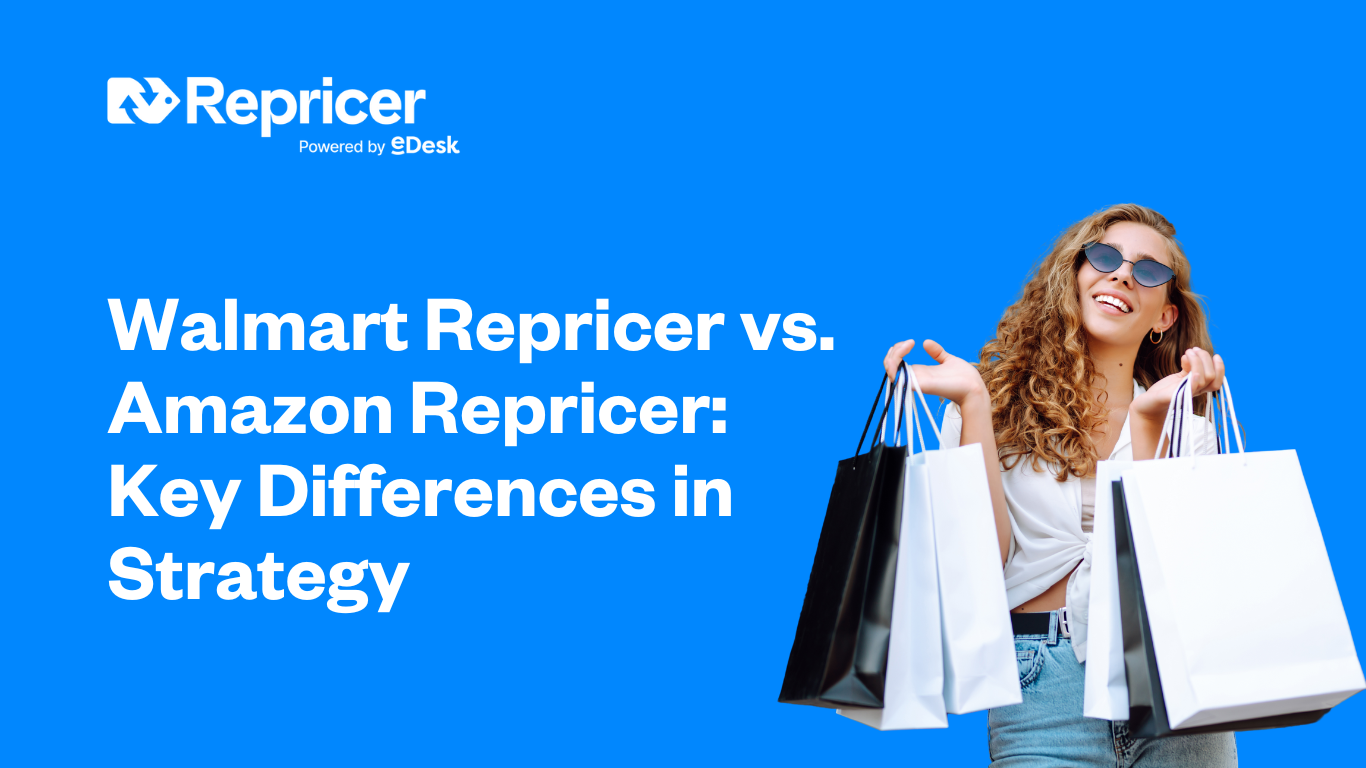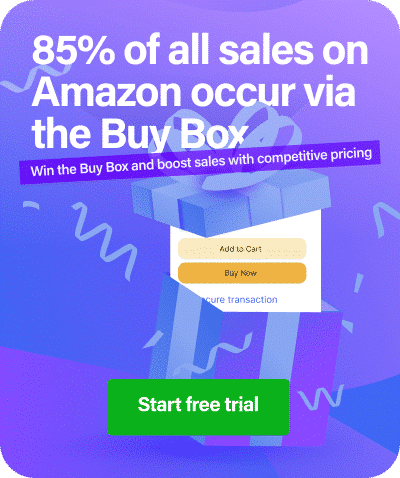As a multichannel seller, you’ve probably discovered that what works perfectly on Amazon doesn’t always translate to success on Walmart Marketplace. While both platforms offer tremendous opportunities, they each require distinct approaches to repricing that reflect their unique marketplace dynamics.
If you’re selling on both platforms and wondering why your Amazon repricing strategy isn’t delivering the same results on Walmart, you’re not alone. The key lies in understanding the fundamental differences between how these marketplaces operate and adapting your pricing strategy accordingly.
Understanding the Marketplace Fundamentals
Before diving into repricing Walmart Buy Box differences, it’s important to recognize the scale and competition levels between these platforms. Amazon dominates with approximately 9.7 million sellers worldwide, while Walmart Marketplace has grown to over 150,000 sellers. This dramatic difference in seller density immediately tells us that competition intensity varies significantly between platforms.
Walmart Marketplace receives over 120 million unique monthly visitors, representing a substantial but less saturated opportunity compared to Amazon’s massive ecosystem. For sellers, this means different strategies are needed to capture each platform’s unique value proposition.
Buy Box Algorithm: The Heart of the Difference
The most crucial distinction between Walmart repricer vs. Amazon repricer strategies lies in how each platform’s Buy Box algorithm operates.
Amazon’s Complex Multi-Factor Approach
Amazon’s Buy Box algorithm considers numerous factors with sophisticated weighting:
- Performance Metrics: Order defect rate, cancellation rate, late shipment rate
- Seller History: Account age, feedback scores, and historical performance
- Fulfillment Method: Strong preference for FBA sellers
- Price Competitiveness: Landed price including shipping and taxes
- Inventory Levels: Consistent stock availability
- Customer Service: Response times and resolution quality
Amazon’s algorithm is known for rotating the Buy Box among qualifying sellers, giving multiple competitors opportunities to win sales throughout the day.
Walmart’s Streamlined Focus
Walmart’s Buy Box algorithm takes a more straightforward approach, primarily emphasizing:
- Total Landed Price: Product price plus shipping costs
- Inventory Availability: Consistent stock levels
- Shipping Speed: Preference for 2-day or faster delivery
- Seller Ratings: Basic performance metrics
Unlike Amazon, Walmart typically awards the Buy Box to one seller rather than rotating it, making sustained wins more valuable but also more challenging to achieve.
API Limitations and Data Accuracy Challenges
One of the most significant technical differences affecting repricing strategy is data reliability. Walmart’s API is known for providing inaccurate or outdated product and pricing information approximately 40% of the time. This substantial error rate means that Walmart’s pricing algorithm vs. Amazon’s requires different approaches to data validation and competitive intelligence.
The best repricer for Walmart Marketplace solutions must account for this data inconsistency by:
- Implementing multiple data verification methods
- Cross-referencing API data with frontend marketplace information
- Building in delays and confirmations before making price adjustments
- Using proprietary scraping techniques for accurate competitor pricing
Amazon’s API, while not perfect, provides more reliable real-time data, allowing for faster and more confident repricing decisions.
Speed and Frequency Considerations
The competition intensity differences between platforms directly impact optimal repricing frequency.
Amazon’s High-Speed Environment
Amazon’s marketplace moves at lightning speed, with prices changing multiple times per day. Successful Amazon repricers must:
- Update prices every few minutes
- React immediately to competitor moves
- Implement aggressive price-following strategies
- Monitor Buy Box rotation patterns continuously
Walmart’s More Measured Pace
Due to less aggressive competition and slower repricing responses on Walmart, the opportunity to increase prices while maintaining the Buy Box is greater. This creates different strategic opportunities:
- Less frequent price updates may be optimal
- Higher profit margins are often sustainable
- Price increases can be tested with lower risk
- Market positioning strategies have more time to develop
Fee Structure Impacts on Pricing Strategy
Multichannel repricing nuances become apparent when examining fee structures. The selling fees on Walmart differ from those on Amazon, which necessitates a repricer tool that can accurately factor in these costs along with your product costs to ensure you never sell below your minimum acceptable profit margin.
Amazon’s Complex Fee Structure
Amazon’s fees vary significantly by category and include:
- Referral fees (typically 8-15%)
- FBA fees for storage and fulfillment
- Monthly subscription fees for Professional accounts
- Additional fees for various services
Walmart’s Simplified Approach
Walmart generally offers:
- No monthly subscription fees
- Competitive referral fees
- Transparent fulfillment costs through WFS (Walmart Fulfillment Services)
These differences require platform-specific minimum price calculations and profit margin protections in your repricing rules.
Platform-Specific Repricing Strategies
Optimizing for Amazon Success
For Amazon, focus your Repricing Strategies on:
- Aggressive Competitive Positioning: React quickly to competitor price changes
- FBA Optimization: Leverage fulfillment advantages in pricing decisions
- Performance Metric Protection: Maintain pricing that supports excellent metrics
- Buy Box Rotation Awareness: Understand and adapt to rotation patterns
Maximizing Walmart Opportunities
For Walmart, emphasize these Advanced Walmart Repricing Strategies:
- Sustainable Profit Focus: Take advantage of less aggressive competition
- Total Cost Optimization: Factor in shipping costs for landed price advantages
- Inventory-First Approach: Prioritize stock availability over aggressive pricing
- Market Position Building: Develop longer-term pricing strategies
Seller Metrics Impact: Platform Variations
The weight given to seller metrics impacts Walmart vs. Amazon in distinctly different ways.
Amazon’s Metric-Heavy Evaluation
Amazon heavily weights seller performance in Buy Box decisions, requiring sellers to maintain excellent metrics across multiple categories. Poor performance in any area can quickly eliminate Buy Box eligibility regardless of competitive pricing.
Walmart’s Simplified Assessment
Walmart’s evaluation focuses primarily on basic performance indicators and availability. While metrics matter, they don’t carry the same complex weighting as Amazon’s algorithm, making it easier for newer sellers to compete on price alone.
Technology Requirements and Integration
Successful multichannel repricing requires sophisticated technology that can handle platform-specific nuances. Look for solutions that offer:
- Platform-Specific Rule Sets: Different strategies for each marketplace
- Custom Fee Calculations: Accurate profit protection for each platform
- Data Validation: Multiple verification methods for pricing decisions
- Performance Integration: Metric monitoring and strategy adjustment
Modern repricing platforms should provide seamless Integrations that connect with your existing tools while maintaining platform-specific optimization.
Price Parity Policies and Cross-Platform Considerations
Both Amazon and Walmart monitor pricing across channels, but their enforcement and policies differ. Understanding price parity policies helps avoid penalties while maximizing platform-specific opportunities.
Amazon tends to be more aggressive in monitoring and enforcing price parity, while Walmart’s approach is generally more focused on providing value to customers rather than policing external pricing.
Marketplace Fee Differences Pricing Impact
The structural differences in marketplace fee pricing create opportunities for strategic positioning. Walmart’s lower fee structure in some categories allows for more competitive pricing while maintaining profit margins, while Amazon’s fees might require different margin strategies.
Optimizing Your Multichannel Approach
To maximize success across both platforms, consider implementing:
- Platform-Specific Minimum Prices: Account for different fee structures
- Differentiated Speed Settings: Faster updates for Amazon, more measured for Walmart
- Custom Competitive Rules: Different competitor monitoring strategies
- Performance-Aware Pricing: Platform-specific metric considerations
The most successful multichannel sellers use Repricer Features that allow for sophisticated rule customization while maintaining centralized management.
Key Takeaways for Strategic Success
The Walmart repricer vs. Amazon repricer decision isn’t about choosing one over the other—it’s about understanding that each platform requires a tailored approach. Successful multichannel sellers recognize that Walmart Buy Box algorithm factors and Amazon’s complex ecosystem demand different strategies.
Bottom Line: While Amazon requires aggressive, high-speed repricing with complex metric management, Walmart offers opportunities for more sustainable pricing strategies with greater profit potential. The key to success lies in implementing platform-specific approaches that leverage each marketplace’s unique characteristics rather than applying a one-size-fits-all strategy.
Your repricing strategy should be as dynamic and differentiated as the marketplaces themselves. By understanding these fundamental differences and implementing appropriate tools and strategies, you can maximize success across both platforms while building a robust, profitable multichannel business.
Ready to optimize your repricing strategy for both platforms? Consider tools that offer true multichannel optimization rather than simple price replication across marketplaces. The investment in platform-specific repricing strategies will pay dividends in improved Buy Box performance, better profit margins, and sustainable long-term growth.





